MotoOnline.com.au brings you the exclusive first Australian test of the 2009 Ducati Streetfighter range after a full day on the road and track.
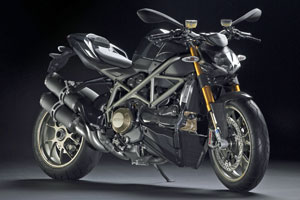
DUCATI STREETFIGHTER SPECIFICATIONS
ENGINE
Engine type: L-Twin cylinder, 4-valve per cylinder Desmodromic, liquid cooled
Bore x stroke: 104 x 64.7mm
Displacement: 1099cc
Compression ratio: 12.4:1
Transmission: Six speed
Power (claimed): 155hp @ 9500rpm
Torque (claimed): 87.5ft-lbs @ 9500rpm
CHASSIS
Frame type: Tubular steel Trellis frame
Streetfighter S front suspension: Öhlins 43mm fully-adjustable upside-down fork with TiN
Streetfighter front suspension: Showa 43mm fully-adjustable upside-down fork
Streetfighter S rear suspension: Fully-adjustable Öhlins monoshock
Streetfighter rear suspension: Fully-adjustable Showa monoshock
Wheelbase: 1430mm
Streetfighter S wheels (front/rear): five spoke in forged light alloy 3.50 x 17 / five spoke forged light alloy 6.00 x 17
Streetfighter wheels (front / rear): 10-spoke in light alloy 3.50 x 17 / 10-spoke light alloy 6.00 x 17
Tyres: Pirelli Diablo Corsa III
Brakes (front / rear): 2 x 330mm semi-floating discs, radially mounted Brembo Monobloc calipers / 245mm disc, single caliper
DIMENSIONS
Streetfighter S weight (claimed, dry): 167kg
Streetfighter weight (claimed, dry): 169kg
PURCHASE DETAILS
Streetfighter S price: $30,990*
Streetfighter price: $24,990*
Streetfighter S colour options: Red or midnight-black over bronze
Streetfighter colour options: Red or pearl-white over black/graphite
Test bike from: Ducati Australia – www.ducati.com.au
* Price for information purposes and is RRP for motorcycle only
Let’s get straight to the point here. Ducati has hit the nail on the head once again in creating one of the most good looking and versatile motorcycles on the market, filling in the gap between its Superbike and Monster ranges to bring us the all-new Streetfighter naked weapon.
There have been many exciting times in my media career as a bike tester, but I must admit that the invitation to the Australian press launch of the Streetfighter had my mind racing as I wondered where exactly the bike would slot into an already impressive line-up of two-wheel exotica.
At a standstill the Streetfighter looks superb, featuring glimpses of its Ducati Superbike big brothers, yet boasting the naked streetfighter culture image that was born on the backstreets of Northern Europe in the 1970s and ’80s.
It’s tough in its stance, using sharper lines and more aggressive styling than the successful Monster range, but climb aboard and you quickly realise that comfort hasn’t been ignored at all.
The Streetfighter has an upright riding feel that places you close to the handlebars and pitches a lot of weight over the front, while it’s still very much like every other Ducati sportsbike I’ve tested in the sense that it’s born from a racing company.
In fact, the rear seating cowl is very much like the current 1198 Superbike, although the seat feels softer and exhaust pipes hang from the right-hand side rather than being mounted under the tail unit.
It’s the front of the bike that I like the most, featuring a bare look and brilliant headlight unit that flows right in sync as you cast your eyes toward the rear-end.
The Streetfighter’s instrumentation features a minimalist look with a compact shape that blends into the aggressive line of the headlight, and it displays rpm and speed, with the former displayed across the screen in a progressive bar graph.
Additionally, the instruments display lap times, DTC status and level selected (if activated on Streetfighter S), time, lap timer, air temperature, coolant temperature, battery voltage, two trips and a trip that automatically starts as the fuel system goes onto reserve.
Warning lights illuminate to signify neutral, turn signals, high beam, rev-limit, low oil pressure, fuel reserve, DTC intervention (if activated on Streetfighter S) and scheduled maintenance.
Information is managed from the left handlebar-mounted switch gear, allowing the rider to scroll through and select from various menus, and it must be noted that even the controls are designed very minimalist and unique to the Streetfighter model.
The dash is easy to read and all of the controls are simple to use and are very functional once you get used to them, although the indicator set-up does feel sharper on the thumb with its tiny push-button set-up than most bikes I have ridden.
Also fitting in nicely are the rear-view mirrors, which are only adjustable by the actual mirror piece on the fly once the main black section is bolted on tightly. The mirrors are low in naked bike terms, yet prove effective enough throughout the riding period.
Once up and away on the first half of the launch – a 100 kilometre road ride before heading to Eastern Creek Raceway in the afternoon – it’s quickly recognised that the bike has a quick-steering feel to it that makes it feel more nimble than it actually looks.
The day would see us switching back and forth between the standard Streetfighter and the more expensive Streetfighter S, both of which feature the same 1098 Testastretta Evoluzione engine, although the S model comes standard with Ducati Traction Control (DTC), Ducati Data Analyser (DDA), Öhlins suspension (instead of Showa), lighter Marchesini wheels and extra carbon-fibre bling.
Riding the S model first, it’s compliant in the way that it reacts and handles over the niggling ripples on the public roads, but the chassis does get a little unsettled at low speeds in the really bumpy turns and that takes time to adjust to.
Where the chassis works best is on smoother surfaces, with a winding uphill set of tight 15km/h-35km/h bends proving the ultimate battleground for the Streetfighter to prove its worth in both agility and stability.
While the suspension is great on smooth surfaces and is stable enough over the bumps and at speed, the only thing that you really need to be aware of is that the front-end wants to wheelie out of turns and causes the front wheel to get light – especially in the lower gears.
The standard model with the Showa suspension is harsher over the bumps compared to the S model’s suspension, but it too steers well on smooth surfaces all things considered.
One of the best things about the Streetfighter is that it’s sporty enough to battle your mate on his 1198, yet so much more practical in everyday living that you’d be hard-pressed to beat its usability unless you were a hardcore track junkie.
The Brembo brakes that are featured on both models work exceptionally well as expected from the top of the line Monobloc front calipers, stopping effectively with the slightest pull of the lever, although the more progressive suspension on the S makes the brakes feel a touch smoother.
As for the rear, they work well when new, but as with all Brembo rear brakes you have to be selective in your use because they tend to overheat quicker than some of the other brands.
Engine-wise it’s clean and crisp at low speed on the road on a cruising rpm range of around 3500-6000rpm of the 12,000 displayed on the dash, and the fresh bikes with less than 1000 kays on the clock feel much easier to get off the lights around town than the Superbike range.
It’s grunty to the point that you get a thrill, yet after spending a couple of days on the 1198 last week it’s nowhere near as powerful – nor is it claimed or supposed to be!
What it does do is provide a good mix or acceleration and power, the type that makes it so very enjoyable to give a handful without the added fear that second gear will make you lose your licence.
After a cruisy ride on the public roads we then head to the race track for a number of sessions on both models, where we’d be able to extract the higher performance of the Streetfighters to see what they’re like when pushed harder.
The results are just as positive, with the suspension on both models working surprisingly well on track, as do the reasonably grippy Pirelli Diablo Corse III tyres, making for a solid track bike despite the lack of fairings and relaxed riding position.
Both the Öhlins suspension on the S and the Showa suspension on the standard model work well on track, taking advantage of the smooth surface and allowing me to push increasingly harder as confidence built.
Linear power makes it incredibly smooth to ride and easy to go fast on once you get used to the quick steering as it falls into the turns, while the added bonus of traction control on the S helps that confidence rise quickly – tempting me to twist the throttle even harder as I see the DTC lights begin to flash on the dash on selected corner exits.
But in saying that, the standard model minus the DTC never stepped out of line at all, even wanting to wheelie more as you sit the bike up off the turn and get hard on the gas.
Power ranges strongly throughout the rev-range, with the shift lights not illuminating until almost 10,000rpm as you race up through the gearbox, which has good shift actuation apart from when you have the engine revving and hard in the torque range.
Stability at speed is generally good unless you’re going over a crest like the one in between turns three and four at the Creek, although the steering damper counters any headshake that might fight its way in when the front gets light.
The lack of a windshield is increasingly annoying on the track at the end of the straight, but it’s only at the end at top-speed that I really find the minimal wind protection a problem.
But that’s a compromise I’m willing to take and, to be honest, the Streetfighter’s practicality in the real world goes a long way toward outweighing the added performance of any superbike on the circuit.
If you’re a rider who spends most of your time on the road with a few track days mixed in, be sure to test a Streetfighter before you lay down your pennies. You may just be surprised with the outcome, because it may just be the sportiest naked bike available on the market.
TECHNICAL INFORMATION:
ENGINE Carlito’s Way move
The 1098 Testastretta Evoluzione needs little introduction. Debuting in 2007, it went on to form the basis of a motor that powered Ducati to Superbike and Superstock World titles, and now it powers Ducati’s most extreme naked.
Producing 85lb-ft of torque and 155hp, the Streetfighter’s L-Twin, Testastretta Evoluzione engine gives both the best power-to-weight and the best torque-to-weight ratios in its class.
New features include enhanced detailing on the cam belt covers and the magnesium dry clutch cover as well as a new black finish for the main outer casings and carbon-grey finish for the crankcases, which employ the same weight-saving technology used for the 1198.
The vacuum die-cast process used to make the crankcases ensures consistent and precise wall thickness and increased strength from absolute material purity while reducing weight by three kilograms compared to those of the 1098 superbike engine.
Using the Testastretta narrow valve angle, super-straight intake ducts and specially shaped combustion chambers, the Desmodromic motor continues to breathe through MotoGP-derived elliptical throttle bodies and four large diameter valves per cylinder to achieve its massive spread of torque.
A high performance six-speed grearbox and racing-style dry clutch makes sure the transmission package delivers the 155hp on offer as efficiently as possible.
The Streetfighter’s engine is protected by twin coolant radiators, carefully curved in pure naked style for optimum performance and engineering beauty. The upper radiator is assisted by lightweight, high flow electric fan assemblies while the lower sits in the front of the belly pan, which also houses a highly efficient oil heat exchanger.
CHASSIS
At 169kg dry weight for the Streetfighter and 167kg for the Streetfighter S, both bikes have an impressive power-to-weight ratio and the need for rock-solid handling and well-planted front-ends to match.
A purpose-built Trellis frame takes care of business at the front-end by using 25.6° of rake compared to the superbike’s 24.5°, and a 35mm longer single-sided swingarm at the rear ensures the Streetfighter’s acceleration need never be compromised. The longer, beautifully created aluminium swingarm follows the same dual construction detail as the superbike models and is anodised finished in black.
The Streetfighter is armed with fully-adjustable 43mm Showa forks up front and a fully-adjustable Showa monoshock at the rear, while the up-spec S model uses fully-adjustable 43mm Superbike-spec Öhlins forks that have sliders treated in low-friction TiN.
Taking care of the rear of the S is a fully-adjustable single Öhlins unit that is also fitted with a top-out spring which helps maintain rear tyre contact under extreme conditions.
Both models feature rear ride-height adjusters.
New 10-spoke wheels in lightweight aluminium are used on the Streetfighter, while the Streetfighter S reduces weight further by using Y-shaped, five-spoke wheels by Marchesini, forged and then machined in lightweight aluminium.
Pirelli Diablo Corse III tyres are utilised on both models.
Both the Streetfighter and Streetfighter S use Brembo’s powerful Monobloc caliper race technology that are machined from a single piece of alloy. The twin Monobloc calipers on the front each have four 34mm pistons that grip 330mm discs.
DTC AND DDA
For the first time ever on a naked sport bike, Ducati has introduced its revolutionary Ducati Traction Control (DTC) system on the Streetfighter S as standard equipment.
The DTC system offers a choice of eight levels, each one programmed with a wheel-spin tolerance matched to progressive riding levels of skill, graded from one to eight – with level eight being the most ‘controlled’ while level one has less intervention from the system.
The system analyses data sent from front and rear wheel speed sensors to detect wheel-spin, and should the system recognise a wheel-spin above a certain threshold the DTC ECU instantly evaluates the many possible wheel-spin scenarios before administering two types of interaction in varying amounts.
The first ‘soft’ stage of system interaction is executed by high speed software that instantly makes electronic adjustment to the ignition timing by administering varying amounts of retardation to reduce the engine’s torque output.
During this initial stage of DTC interaction, both outer warning lights on the Streetfighter instruments – normally used to signify over-rev – illuminate to signify that DTC is being applied.
If the DTC software detects that the first ‘soft’ stage of system interaction is inadequate to control the wheel-spin, it continues to administer ignition retardation and instructs the engine ECU to initiate a pattern of constantly increasing injection cuts until the full injection is cut.
During this second stage of system interaction, both outer and central warning lights fully illuminate to signify that DTC has also initiated injection cuts.
After either stage one (ignition retardation) or stage two (pattern of injection cuts or full cut), the system incrementally returns to the original ignition and injection mapping as the wheel speeds approach equalisation. This carefully programmed return to full power delivery is the real key to DTC’s smooth and efficient operation.
The Ducati Data Analyser (DDA) – complete with PC software, a USB-ready data retrieval card and instructions – provides a graphic presentation of data from various channels of information. The DDA is available for the Streetfighter from Ducati Performance, and is supplied as standard equipment on the Streetfighter S.
DDA records numerous channels of data including throttle opening, vehicle speed, engine rpm, engine temperature, distance travelled, laps and lap times. The system also automatically calculates engine rpm and vehicle speed data, enabling gear selection as an extra channel of information. Another channel of data is also dedicated to recording the DTC index, which can then be viewed as a graphic trace that shows the amount of DTC interaction during wheel-spin.
At the end of a ride or track session, 4mb of data can be downloaded to a PC ready to compare, analyse and get an inside view on the performance of the rider and Streetfighter.
Click here for our exclusive video of the Streetfighter launch


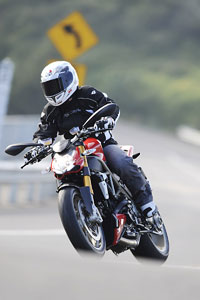
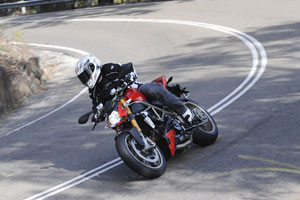
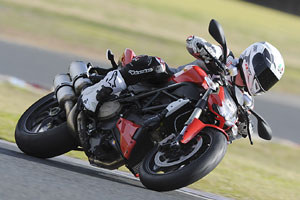
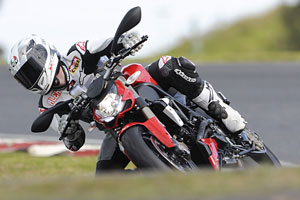
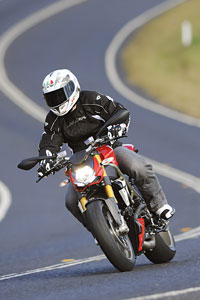





Newsletter